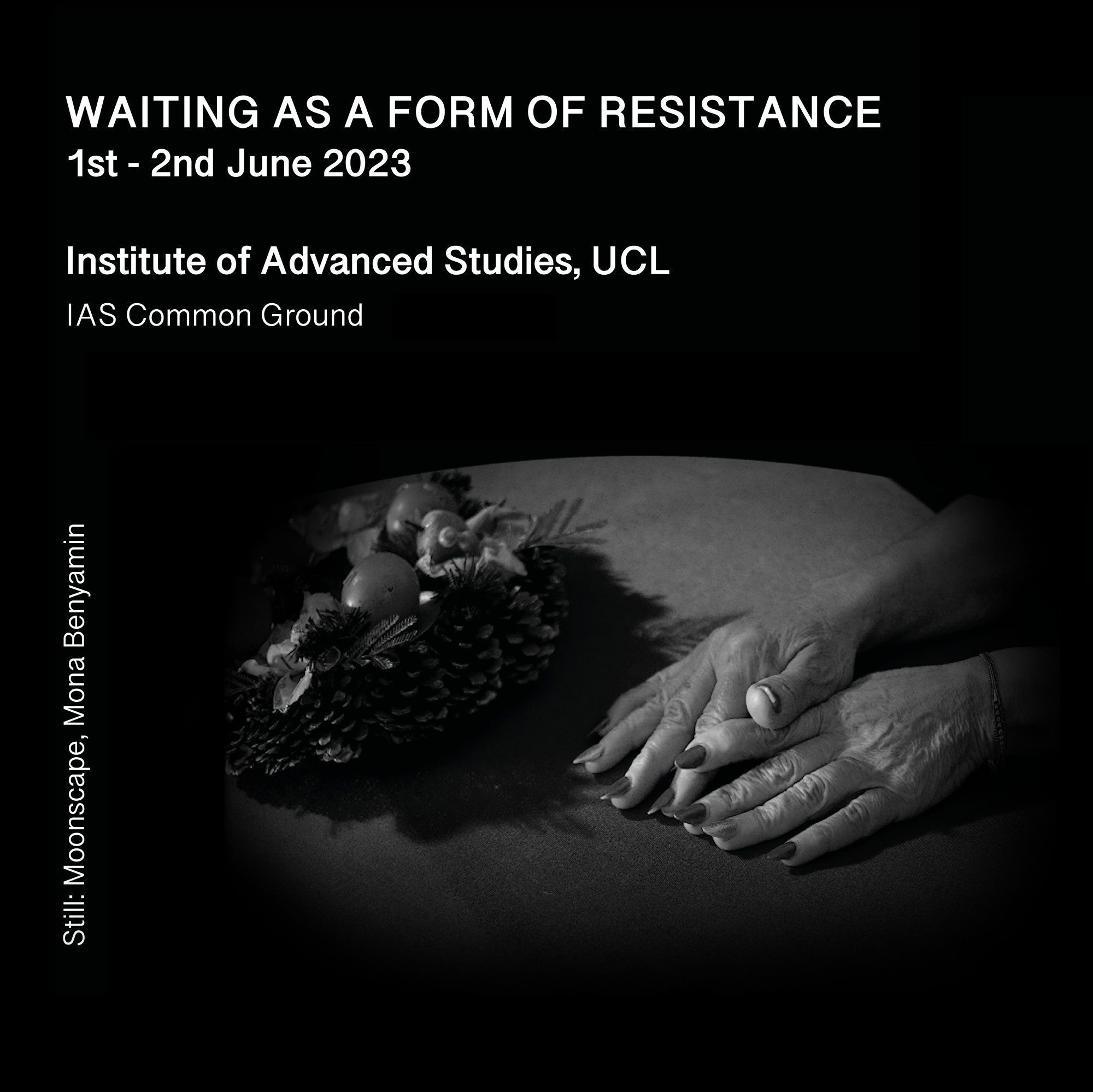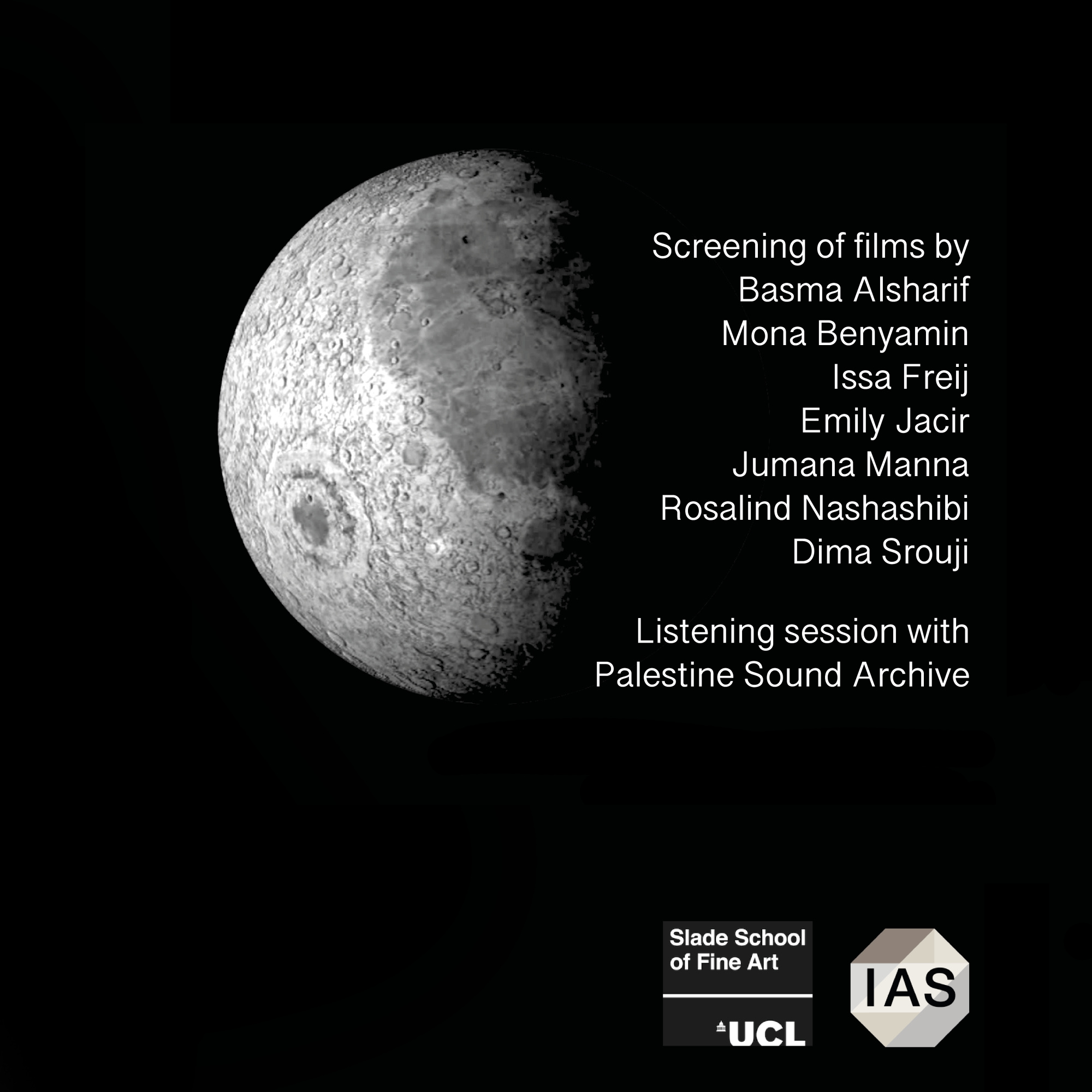Waiting as a form of resistance
A symposium organised by Slade School of Fine Art students, as part of Equality, Diversity and Inclusion initiative - University College London.
Featured Media


Working from Waiting as a form of resistance, the symposium will present films and art works that range from direct engagement with politics and protest, to forms of quiet and sustained refusal.
The symposium theme takes its cue from Ghassan Hage who wrote, “One can assume waiting is an action that is passive and lacks agency. Yet, we all wait for different futures and in different modalities.” Hage, Ghassan. Waiting. (2009. Melbourne: Melbourne University Press, pp.1-3) Waiting can simultaneously be a form of resistance that impedes change, and it is also perceived as disengagement of institutional temporality of past, present, and future. To quote from Ariella Azoulay: “Waiting slows down accelerated motions of progress; it is to dwell on past injustices that were pushed on the margins of history (Potential History Unlearning Imperialism (Verso, 2019, pp. 41-44). For the Waiting symposium, it means to recognize the spaces within the so-called progress. It is a way to stop and attune to the past and to listen to voices that have been consistently marginalised.
Can waiting create a shared momentum for imagining and actualising a more expansive liberatory future? Waiting, in itself, is one form of resistance, embodying a rich plurality. For some artists, this is a direct engagement with their political environment, and a protest at the level of the collective. For others, the form of resistance is a quiet and sustained refusal enacting visions for a radically different and more equitable social and cultural configuration.
Waiting can be charged as a political tool articulated in different institutional dimensions with universities applying bureaucratic frameworks to organise and regulate waiting into a social system. Thus, stability is maintained by presenting Waiting as natural, yet it is a social fabrication that signals institutional violence. This form of waiting exists on borders, in precincts, and ethno-displacements that create exclusionary modes of existence to maintain a state of institutional stability.
Drawing on these diverse registers of resistance the symposium will respond specifically to the context of Palestine and Israel to ask: What strategies can art and artists develop to resist apartheid, state oppression and structural racism. How can artistic and academic freedom prefigure alternatives to colonial narratives? How can our cultural and academic institutions create platforms for voices experiencing state censorship, violence and infringement of human rights.
Schedule Thursday 1 June
4-6pm, Screenings
Dima Srouji, Sebastia
Sebastia, a small archaeological town, sits on top of a hill Northwest of Nablus, Palestine surrounded by Shavei Shomron, an illegal Israeli settlement and confiscated agricultural fields of olive groves and apricot trees. This ancient site was excavated multiple times over the last century by colonial archaeologists funded by Zionist individuals and institutions. The first excavation of 1908 led by Harvard University took advantage of Sebastia locals including women, men, and children as cheap labour digging their own land for the sake of biblical archaeology. Each excavation extracted soil and artifacts from the ground, taking what they considered valuable to their home institutions and leaving pottery shards and rubble on the surface. Today, what’s left of the archaeological monuments is contested by the nearby settlement as well as the Israeli military. The Roman Forum is a battlefield, but the locals are incredibly resilient.
Issa Freij, Last supper
In Issa Freij’s beautiful, elegiac cinema verité documentary short, The Last Supper, the viewer is invited to experience the construction of Israel’s Separation Wall as it happened, live, from villagers’ kitchens and doorsteps in Abu Dis, a Palestinian village on the outskirts of Jerusalem.
As the 20-foot-high monstrosity is installed, we see the slow but inexorable defacement of a landscape and a community that will now be isolated from Jerusalem. The villagers’ stoic resignation to their fate is evident. They poignantly bid farewell to their scenic views and their neighbors, who will soon be unreachable on the other side of the wall. A powerful testament to the experience of living through this transformative, traumatic, and wrenching period. Source: Jerusalem Story.
Rosalind Nashashibi, Electrical Gaza
In Electrical Gaza Nashashibi combines her footage of Gaza, and the fixer, drivers and translator who accompanied her there, with animated scenes. She presents Gaza as a place from myth; isolated, suspended in time, difficult to access and highly charged. Commissioned by the Trustees of Imperial War Museum. Produced by Kate Parker.
Jumana Manna, A Sketch of Manners (Alfred Roch's Last Masquerade)
Alfred Roch, member of the Palestinian National League, is a politician with a bohemian panache. In 1942, at the height of WWII, he throws what will turn out to be the last masquerade in Palestine. Inspired by an archival photograph, A Sketch of Manners (Alfred Roch’s Last Masquerade) recreates an unconventional bon vivant aspect of Palestinian urban life before 1948. Posing silently for a group photo, the unmasked and melancholic pierrots accidentally personify the premonition of an uncertain future.
6-7pm, Listening Event
Palestine Sound Archive
Palestine sound archive is a research project born out of the archive, focused on sampling, remixing and reissuing vintage Palestinian and Arabic cassettes. It is a collaboration between Arab and non-Arab DJs, producers and artists interested in shedding new light on the richness and diversity of Palestinian musical heritage. The aim behind the project is to safeguard the Palestinian sound archive and to make it more accessible in online website exhibition that will be available soon with more than 3000 Palestinian cassettes for free to listen to or read about it. The physical formats under Majazz project the first independent Palestinian reissue music label. It is also an outreach research project to connect Palestinian bands from the 60s, 70s and 80s with new audiences and to make their music available through streaming platforms both in their original form and reinterpreted and remixed by DJs, artists and musicians.
Schedule Friday 2 June
4-6pm, Screenings
Rosalind Nashashibi, Dahiet Al Bareed, District of the Post Office
One slow, hot afternoon in a neighbourhood built to be a utopian suburb for employees of the Palestinian Post Office; now becomes a lawless no-man’s-land between occupied East Jerusalem and Ramallah.
Emily Jacir, Letter to a Friend
A close friend is asked to start an investigation before an inevitable act occurs. Interlacing images, textures, movements, traces, and sounds from over a century, letter to a friend recounts in minute detail a home and street in Bethlehem.
Mona Benyamin, Moonscape
Moonscape* is a short film which takes the form of a music video for a ballad/middle of the road song, performed as a duet between a male and female singer, in Arabic. The song traces the story of a man called Dennis M. Hope, who claimed ownership of the Moon in 1980 and thus founded the Lunar Embassy – a company that sells land on a variety of planets and Moons, and makes a connection between his story and that of the director's – a young Palestinian woman living under the Israeli occupation, longing to end the misery of her people in any way possible.
The visuals of the film are a hybrid of surrealist scenes from the Arab music industry, reenacted by the artist’s parents who also play the roles of the singers in the film, and film noir; in addition to found footage from the NASA archives, references from canonic films which influenced the art world and show representations of the Moon, and screenshots of Email correspondences with staff members of the Lunar Embassy. All in order to explore the relationship between hope, nostalgia and despair.
Basma Alsharif, Home Movies Gaza
Home Movies Gaza introduces us to the Gaza Strip as a microcosm for the failure of civilization. In an attempt to describe the everyday of a place that struggles for the most basic of human rights, this video claims a perspective from within the domestic spaces of a territory that is complicated, derelict, and altogether impossible to separate from its political identity.
Funded by Slade EDI Committee, Student Initiatives Fund.
Location
The IAS Common Ground is room G11, on the ground floor of the South Wing. It is step-free / wheelchair accessible.
Booking/Registration
Organisers
Jumana Emil Abboud
Moza Almazrouei
Niki Kohandel
Nastassja Simensky